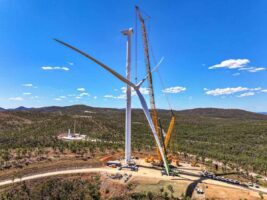The Clean Energy Finance Corporation is set to make its first investment in grid infrastructure, even before the creation of the Grid Reliability Fund , offering a $125 million facility to help privately owned transmission company TransGrid connect the federal government’s Snowy 2.0 pumped hydro project to the main grid.
The CEFC will establish a $125 million debt facility with TransGrid, which will be used to finance the design, construction, operation and maintenance of a new 300kV switching station and transmission lines that will connect Snowy 2.0 to the main grid.
The CEFC’s CEO Ian Learmonth said that the green fund’s first investment in transmission network infrastructure would enable the development of zero emissions energy storage which in turn would help support the development of new renewable energy projects, particularly the addition of 1,900MW of wind and solar projects being built as part of a Renewable Energy Zone established in South-West New South Wales.
“Investment in new storage, transmission and related infrastructure is essential to support the security and reliability of the grid during Australia’s clean energy transition,” Learmonth said.
“Our ability to offer investment certainty in challenging market conditions is evidence of the critical role the CEFC can play in supporting grid related developments. Snowy 2.0 offers large scale energy storage and quick start electricity generation during peak demand, providing critical security and reliability services to the NEM. We are delighted to be working with TransGrid Services in investing in this exciting project.”
The Morrison government is currently in the process of establishing a new $1 billion Grid Reliability Fund, to be administered by the Clean Energy Finance Corporation.
Legislation that would establish the fund is currently being considered by the federal parliament. While there is broad support across the political spectrum for the establishment of the Grid Reliability Fund, its creation is being paired with controversial amendments that would open up the CEFC to making investments in gas projects, including those that may operate at a loss.
However, the CEFC said that it was confident that it would be able to administer the new fund in a way that would enable the wider development of new low emissions energy sources. It is not clear whether this investment will be transferred to that fund if and when it is created, or remain as part of the overall funding envelope.
“Through our specialist Clean Futures Team, we have a strong focus on investment in grid augmentation, including transmission, interconnectors, renewable energy zones, hydro, grid-scale battery storage and hydrogen,” Learmonth added.
“This investment with TransGrid Services is an example of the kind of further national building investments we will be able to make through the [Grid Reliability Fund] once it is established.”
TransGrid said that it was pleased to be involved in the delivery of new network infrastructure that would enable one of Australia’s largest energy storage projects.
As part of its preparation of the 2020 Integrated System Plan, the Australian Energy Market Operator included the need for an additional 500kV transmission network line, dubbed HumeLink, to bolster Snowy 2.0’s connection to the wider electricity system. The HumeLink line is expected to cost an estimated $950 million to $1.76 billion.










